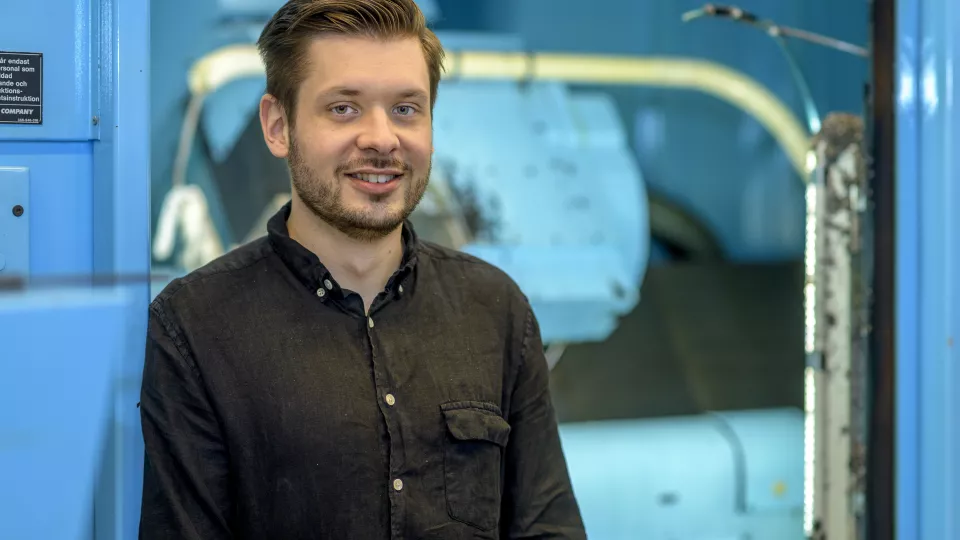The production of most utility products – from brake disks in cars to thermostats for radiators – requires some cutting process such as turning, drilling or milling. These processes require specially adapted tools – cutting plates that are fixed into a tool holder of some kind. These tools wear out at different rates depending on the material to be processed and the processing method.
Unusual and exotic materials
At the Division for Production and Materials Engineering at Lund University, doctoral student Mike Olsson is leading a project aiming to increase expertise among manufacturers in southern Sweden on the production of components in unusual and exotic materials, to enable these companies to manufacture advanced components that not many can currently produce. Mike Olsson explains why:
“Sweden contributes several hundred million SEK per year to the CERN research facility in Switzerland. In connection with this, Sweden also gets to produce and sell experimental equipment components to the facility for an equivalent amount. But we don’t do so; we deliver for a much smaller sum and usually only simple components, with the risk that our companies will lose out in competition with low-income countries, for example.”
Components to ESS and MAX IV
In addition, Lund now has the research facilities of ESS and MAX IV. John Weisend, group leader for specialised technical service at ESS, explains that once ESS is fully operational, it will benefit greatly from companies in the region capable of producing components for upgrades, repairs, service and maintenance. However, he points out that the high performance requirements in the accelerator and various instruments at ESS often demand that manufactured components be very precise in terms of surface finish and fit, for example, with regard to tolerances.
Mike Olsson’s project is therefore aimed at manufacturing companies in Skåne and Blekinge which could potentially supply this kind of components. Producing advanced components for the research facilities thus requires both precision and use of materials that are new to these companies, materials with high requirements for purity, among other things.
“The companies we are working with have computer-controlled production machinery enabling movements and speed to be programmed, as well as how much is to be produced at a time, etc. Within the project, we can help the companies to develop the right tools and to adapt the programming of the production machinery so as to achieve the correct quality in the manufactured components.”
The new materials are difficult to process
One of the problems is that all the new, pure materials, such as pure copper, tungsten, niobium, tantalum and molybdenum, have special properties that make them particularly difficult to process.
“When turning a material on a lathe, you get a ‛shaving", explains Mike Olsson. “With soft materials such as copper and niobium, the shaving does not break into pieces, but it can be a long piece that can get tangled up and start to mess up the surface or damage it. Tungsten, on the other hand, is very brittle and the surface can get very bad; it also wears out the tools a lot.”
A survival strategy.
If the companies themselves were to experiment to find out which tools work best and how to programme their processing machinery for optimal production, the process would be very expensive. It would take a long time and involve a lot of waste before a company could arrive at the best way of handling the specific material. Moreover, many of the materials are very expensive; tungsten for example costs SEK 1100/kg and niobium SEK 2500/kg. The companies do not want to purchase expensive materials and then get it wrong, according to Mike Olsson, who explains:
“So we carry out the tests instead! We gather experiences from various sources and test different tools for the different materials to see whether we can meet the requirements set by ESS and MAX IV, for example. This knowledge is also of use in our research. At the moment, however, we are working on reducing the duration of the testing processes so that the companies only need to set aside 1–2 days for this.”
Regional companies take part
Examec is one of the companies that will soon be testing the processing of various materials on its own machinery. For several years, they have supplied components to research facilities such as CERN; now they will primarily be testing the processing parameters for the processing of high-purity copper to manufacture cavities for use in various particle accelerators, explains the company’s CEO, Mats Ohlsson.
“We see it as a survival strategy to learn to manage increasingly difficult manufacturing processes – processes for which there is less expertise in low-income countries.”
Mats Ohlsson believes that maintaining close cooperation between universities and manufacturing companies could result in interesting new products and applications.
“Generally, I believe that there is potential for development in Sweden”, concludes Mats Ohlsson.
